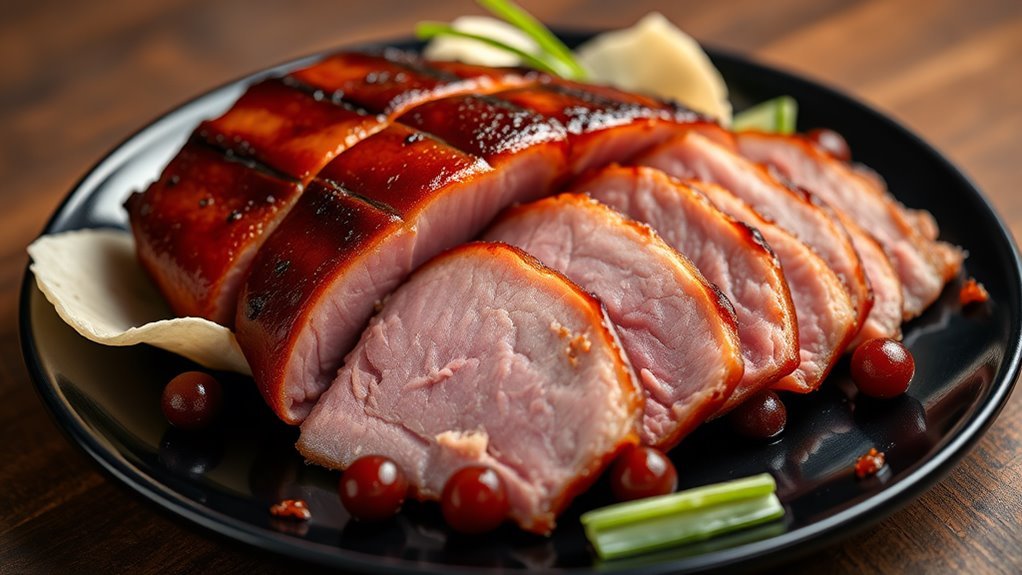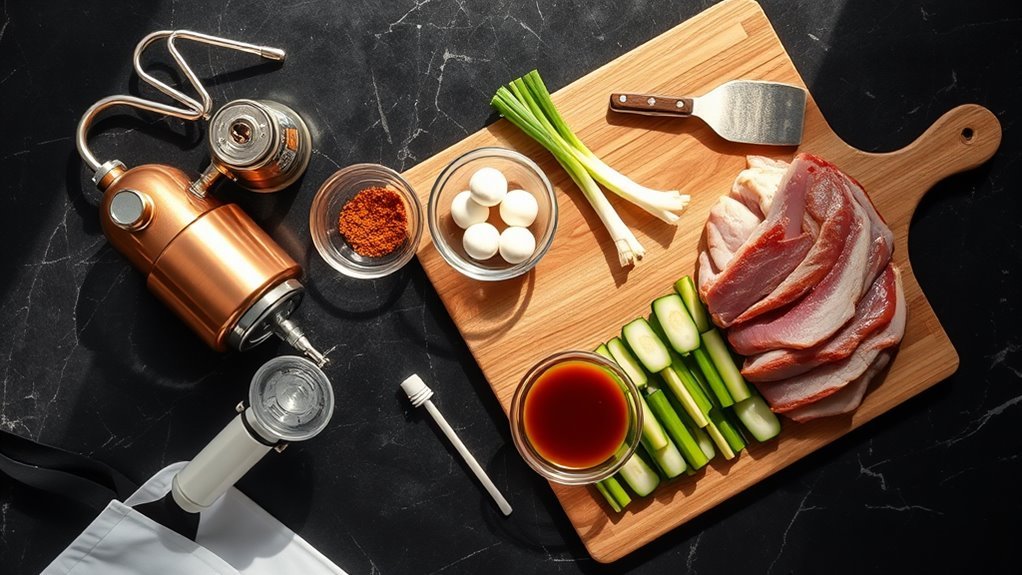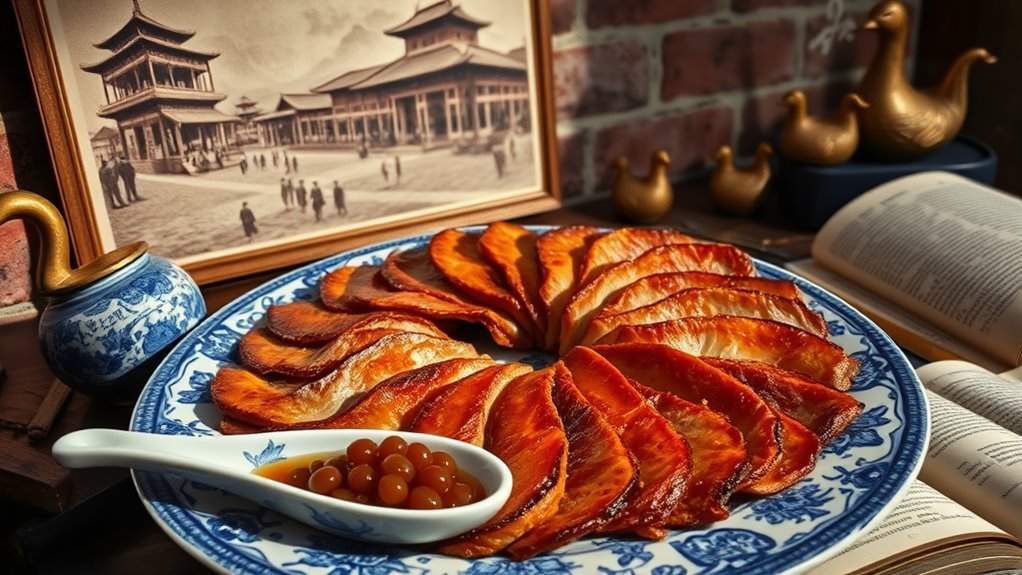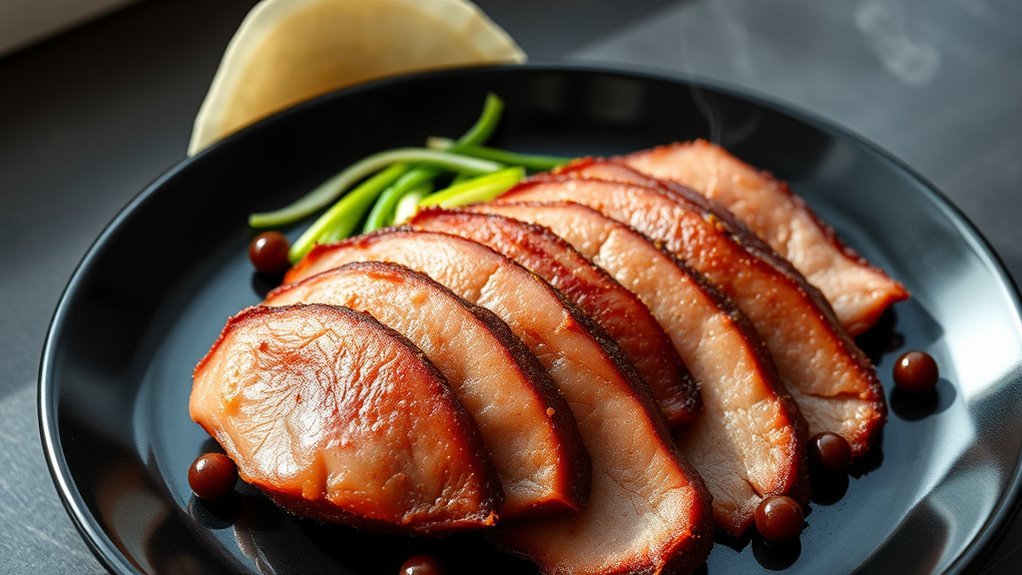Alright folks, let’s talk about Peking duck. This dish has been a staple at Chinese banquets for ages, and for good reason. The crispy skin, tender meat, and that sweet-savory hoisin sauce are a match made in culinary heaven. But today, we’re shaking things up a bit. We’re taking that beloved classic and giving it a modern twist with hoisin caviar.
Now, don’t let the word “caviar” throw you off. We’re not talking about fish eggs here; we’re using a little kitchen magic called molecular gastronomy to turn regular hoisin sauce into these elegant little pearls that burst with flavor. It’s a fun way to elevate the dish while still keeping all the traditional elements you love. So, roll up your sleeves, and let’s dive into this delightful fusion of old and new. You’re going to want to get in on this!
Ingredients

Peking Duck’s signature ingredients center around a whole duck of moderate size, typically 4-5.5 pounds, which serves as the foundation of this classic dish. The duck requires specific preparation ingredients, including honey or maltose for the essential skin-crisping glaze, and aromatic components like ginger, garlic, and star anise for the internal stuffing. Traditional marinades incorporate rice wine, soy sauce, and vinegar, while the final preparation relies heavily on hoisin sauce as the primary condiment. Dark soy sauce adds deep color and rich flavor to the marinade, typically requiring about 3 tablespoons per recipe.
The accompanying elements are equally important, featuring fresh scallions and cucumber that provide textural contrast and brightness to the rich duck meat. The dish’s success depends on the careful balance of thickening agents, particularly maltose or honey for the outer glaze, and arrowroot or cornstarch for marinade consistency. These components work together with the aromatic stuffing mixture to create the distinctive flavor profile that defines authentic Peking Duck.
Recipe

| Ingredient | Amount |
|---|---|
| Whole duck (4-5 lbs) | 1 |
| Hoisin sauce | 1 cup |
| Calcium lactate | 2g |
| Sodium alginate | 5g |
| Chinese five-spice powder | 2 tbsp |
| Maltose or honey | ¼ cup |
| Green onions | 1 bunch |
| Cucumber | 1 |
| Chinese pancakes | 24 pieces |
The legendary Peking Duck is renowned for its crackling crisp skin and tender meat, traditionally served with thin pancakes and hoisin sauce. This modern interpretation elevates the classic by incorporating molecular gastronomy techniques to create hoisin caviar spheres, adding an elegant twist to the traditional condiment.
The key to achieving the perfect Peking duck lies in the preparation, which begins days before cooking. The duck must be thoroughly cleaned, air-dried, and properly seasoned to develop the signature crispy skin and succulent meat that this dish is famous for. The white Beijing duck breed has historically been the most prized variety for creating authentic Peking duck due to its superior meat quality and texture.
Begin by cleaning the duck and patting it dry. Using a bicycle pump or air compressor, separate the skin from the meat. Blanch the duck in boiling water for 30 seconds, then hang it in a cool, ventilated place for 24-48 hours. Before roasting, brush the skin with maltose solution and season with five-spice powder. Roast at 350°F (175°C) for about 1.5 hours, or until the skin is golden brown and crispy. For the hoisin caviar, mix hoisin sauce with calcium lactate, then drop the mixture into a sodium alginate bath to form spheres.
The success of this dish heavily depends on the drying process – guarantee proper air circulation and maintain a consistent temperature. When making the hoisin caviar, the sodium alginate bath must be at room temperature, and the spherification process requires gentle handling. For best results, serve the duck immediately while the skin is still crispy, and prepare the caviar just before serving to maintain its texture.
Cooking Tips

Mastering traditional Peking duck requires understanding several essential techniques that elevate this dish from good to exceptional.
We’ll start by pumping air under the skin to separate it from the fat layer – this is vital for achieving that signature crispiness.
Next, we’ll scald the duck with boiling water and apply multiple coats of maltose glaze.
Don’t skip the 24-hour air-drying process; it’s what creates that perfectly crisp skin we’re after.
For roasting, we’ll use a two-stage approach: high heat for browning, then lower heat to finish cooking until the internal temperature reaches 165°F.
Originally developed by the Yuan dynasty court, this roasting technique has been perfected over centuries of Chinese culinary tradition.
History

Beyond the intricacies of preparation, there’s a rich legacy behind this revered dish that started during China’s Yuan Dynasty (1271-1368).
We can trace its origins to imperial dietitian Hu Sihui, who first recorded it in his groundbreaking text “Important Principles of Food and Drink.”
What began as a royal secret soon became Beijing’s signature dish during the Ming Dynasty, with restaurants like Bianyifang leading the way. The dish’s global recognition surged when it played a pivotal role in US-China diplomatic relations during the 1970s.
Final Thoughts

Every innovation in Peking duck‘s modern preparation represents a delicate balance between honoring centuries-old traditions and embracing contemporary techniques.
We’re seeing creative adaptations in home kitchens and restaurants alike, where chefs blend time-tested methods with modern conveniences while maintaining the dish’s integrity. The use of homemade hoisin sauce offers a personalized touch that accommodates dietary needs while preserving authentic flavors. From simplified air-drying to precise oven temperatures, these adaptations make this cherished dish more accessible without sacrificing its essence.
Modern innovation meets ancient tradition as chefs revolutionize Peking duck preparation while preserving its authentic spirit and flavors.
The addition of luxurious elements like caviar shows how we can respectfully evolve classic preparations.
Whether traditional or contemporary, the magic of Peking duck continues to captivate diners and inspire culinary innovation.
Conclusion
So there you have it, folks! This modern take on Peking Duck with Hoisin Caviar is a real game changer. It’s all about balancing that crispy, juicy duck with the sweet and savory pop from the hoisin caviar – trust me, it’s a combo that will make your taste buds do a little happy dance. Give it a whirl for your next family gathering or special occasion; it’s sure to impress without turning you into a frantic mess in the kitchen. Remember, cooking is about having fun and experimenting, so don’t be afraid to make it your own. Enjoy every bite, and happy cooking!

